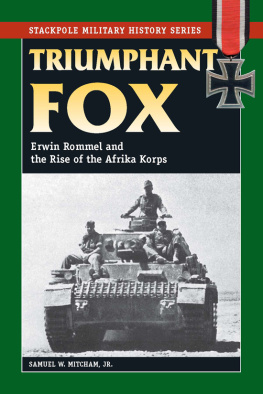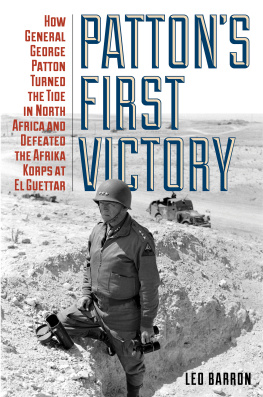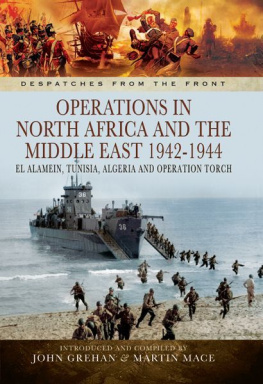FIRST BLOOD IN NORTH AFRICA
FIRST BLOOD IN NORTH AFRICA
Operation Torch and the U.S. Campaign in Africa in WWII
Jon Diamond
STACKPOLE BOOKS
Guilford, Connecticut
Published by Stackpole Books
An imprint of Globe Pequot
Distributed by
NATIONAL BOOK NETWORK
Copyright 2017 Jon Diamond
All rights reserved. No part of this book may be reproduced in any form or by any electronic or mechanical means, including information storage and retrieval systems, without written permission from the publisher, except by a reviewer who may quote passages in a review.
British Library Cataloguing in Publication Information available
Library of Congress Cataloging-in-Publication Data
Names: Diamond, Jon (Jonathan Russell), author.
Title: First blood in North Africa : Operation Torch and the U.S. campaign in Africa in WWII / Jon Diamond.
Description: Lanham, Maryland : Stackpole Books, an imprint of Globe Pequot, trade division of the Rowman & Littlefield Publishing Group, Inc., 2017. | Includes bibliographical references.
Identifiers: LCCN 2016033734 (print) | LCCN 2016034537 (ebook) | ISBN 9780811717779 (pbk.) | ISBN 780811765619 (e-book) | ISBN 9780811765619 (ebook)
Subjects: LCSH: World War, 1939-1945CampaignsAfrica, North. | Operation Torch, 1942. | Africa, NorthHistory, Military.
Classification: LCC D766.82 .D53 2017 (print) | LCC D766.82 (ebook) | DDC 940.54/231dc23
LC record available at https://lccn.loc.gov/2016033734
 The paper used in this publication meets the minimum requirements of American National Standard for Information SciencesPermanence of Paper for Printed Library Materials, ANSI/NISO Z39.48-1992.
The paper used in this publication meets the minimum requirements of American National Standard for Information SciencesPermanence of Paper for Printed Library Materials, ANSI/NISO Z39.48-1992.
Printed in the United States of America
CONTENTS
T he interval from October 1942 through January 1943 has been referred to as a turning of the tide in the epic struggle of World War II. During this three-month time frame, five major land campaigns were conducted, leading to staggering losses for the Axis partners of Germany and Italy as well as the Japanese Empire. These included the protracted battles for Papua New Guinea; Guadalcanal, in the southern Solomon Islands of the South Pacific Area; across the Western Desert of the North African littoral, culminating in the First and Second Battles of El Alamein; the defense of Stalingrad, resulting in the surrender of large numbers of Axis coalition troops, comprising mostly the Wehrmachts Sixth Army; and the invasion of Northwest Africa on November 8, 1942, Operation Torch.
First, in the Southwest Pacific Area, after the Japanese withdrew from their overland assault on Port Moresby, New Guinea, Gen. Douglas A. MacArthurs American and Australian forces captured the Japanese garrisons at Buna and Gona on the northern coast of Papua New Guinea, albeit at horrific cost to those troops fighting in that hellacious locale. The victory over the tenacious Japanese defenders at Buna and Gona, along with a previous repulsion of an enemy amphibious assault at Milne Bay in late August and early September 1942, effectively ensured that Port Moresby would not be attacked again from the eastern half of New Guinea.
Second, in the South Pacific, the U.S. Marine Corps 1st Division (Reinforced), along with U.S. Army contingents initially from the Americal (23rd) Infantry Division, held off repeated Japanese land, sea, and air assaults to continue to maintain control over Henderson Field on the northern plain of the southern Solomon Island, Guadalcanal. Eventually more-substantial American forces went on the offensive, causing the Japanese to completely withdraw from Guadalcanal by the end of the first week of February 1943.
Third, at Stalingrad, Soviet forces made an epic defense within that citys streets against the Wehrmachts Gen. Friedrich von Paulus and his vaunted Sixth Army, some of the finest troops in the German army. The planning for Operation Torch would have been for naught had the Germans won their epic clash with the Soviets. By October 1942 two Nazi armies had driven forward deep into the Soviet interiors Caucasus Mountains but had become bogged down only a few miles from the oil fields that Hitler required to continue his war effort. Just to the north of the Caucasus Mountains was the city of Stalingrad on the Volga River. It was to become the farthest point that the German Sixth Army and 4th Panzer Army would advance to. On October 2 von Paulus unleashed his last offensive against the Russians in Stalingrad, namely, a 2,000-yard deep pocket, which included the gutted remains of buildings and factories. The German gains were measured in yards, and von Paulus admitted to his peers, Things are going very slowly, but every day we make a little progress. The whole thing is a question of time and manpower. The Wehrmacht could not do anything to delay winters onset, nor could they tap into any ready reinforcements for von Pauluss dwindling Sixth Army ranks. The German High Command knew that if Stalingrad was not captured within a month, the whole Nazi position in southern Russia would be a precarious one since their flanks to the north and west were held by Rumanian troops. As it happened, the flanks were overrun by a Russian winter counteroffensive, and despite Gen. Erich von Mansteins attempt to open a corridor to von Pauluss troops, the Sixth Army was encircled and forced to surrender. The loss of the Sixth Armys twenty divisions doomed the German invasion of the Soviet Union.
Fourth, British prime minister Winston S. Churchill and his chief of the Imperial General Staff (CIGS), Gen. Sir Alan Brooke, needed to engage the Axis forces somewhere; however, both were dreadfully afraid of sending another expeditionary force to the European continent or Scandinavia after the disasters at Dunkirk and Norway in the spring of 1940. In the future both British leaders would also learn that an attack on a fortified continental port was suicidal, as evidenced at Dieppe during Operation Jubilee in August 1942, which inflicted horrific casualties on the assaulting Canadian infantry and British armor. An understanding of the campaign in Northwest Africa requires a description of the combat events that occurred in the Western Desert of Egypt and Libya from December 9, 1940, through November 8, 1942, the latter date corresponding to the Operation Torch landings in French Morocco and Algeria.
The Italian Fascist dictator, Benito Mussolini, gave the British War Cabinet its entre into a land battle against the junior Axis partner across the North African littoral and in rugged and remote East Africa, rather than on the European continent. On June 11, 1940, as the French were about to capitulate, Mussolini declared war on Britain and France. Soon thereafter, in the late summer of 1940, Italys Tenth Army under Gen. Rodolfo Graziani launched its laborious advance across the frontier from Cyrenaican Libya into Egypt. This would later develop into a full-scale theater of war, which pitted British and Commonwealth forces against the Axis fascist partners. Initially Gen. Archibald Wavell, commander in chief (C-in-C), Middle East, decided that he had to attack and rid this threat against his western flank by the Italian presence with a short and swift operation, lasting from four to five days at the most, and taking every advantage of the element of surprise in the SofafiSidi BarraniBuqbuq area. The British C-in-C faced 215,000 Italians with only 36,000 of his own forces. Wavell, after detailed clandestine planning, sent a relatively small combined infantry, the 4th Indian Division, and armored contingent, the 7th Royal Tank Regiment (RTR) with their heavy Infantry tanks nicknamed Matildas. This combined British and Indian unit, initially called the Western Desert Force, was under the command of Lt. Gen. Sir Richard OConnor. Its orders were to conduct a limited raid: from December 911, 1940, to evict those elements of Mussolinis Italian Tenth Army from their fortified Egyptian desert camps at Nibeiwa as well as at Tummar East and West. In addition, OConnors Western Desert Force would then proceed to capture the port town of Sidi Barrani. In all, a total of 20,000 Italians surrendered and 180 artillery guns and 60 tanks were seized as thousands more streamed westward in a pell-mell fashion across the coastal road toward Italys other port garrisons.











![Atkinson - An army at dawn: [the war in North Africa, 1942-1943]](/uploads/posts/book/178818/thumbs/atkinson-an-army-at-dawn-the-war-in-north.jpg)





 The paper used in this publication meets the minimum requirements of American National Standard for Information SciencesPermanence of Paper for Printed Library Materials, ANSI/NISO Z39.48-1992.
The paper used in this publication meets the minimum requirements of American National Standard for Information SciencesPermanence of Paper for Printed Library Materials, ANSI/NISO Z39.48-1992.